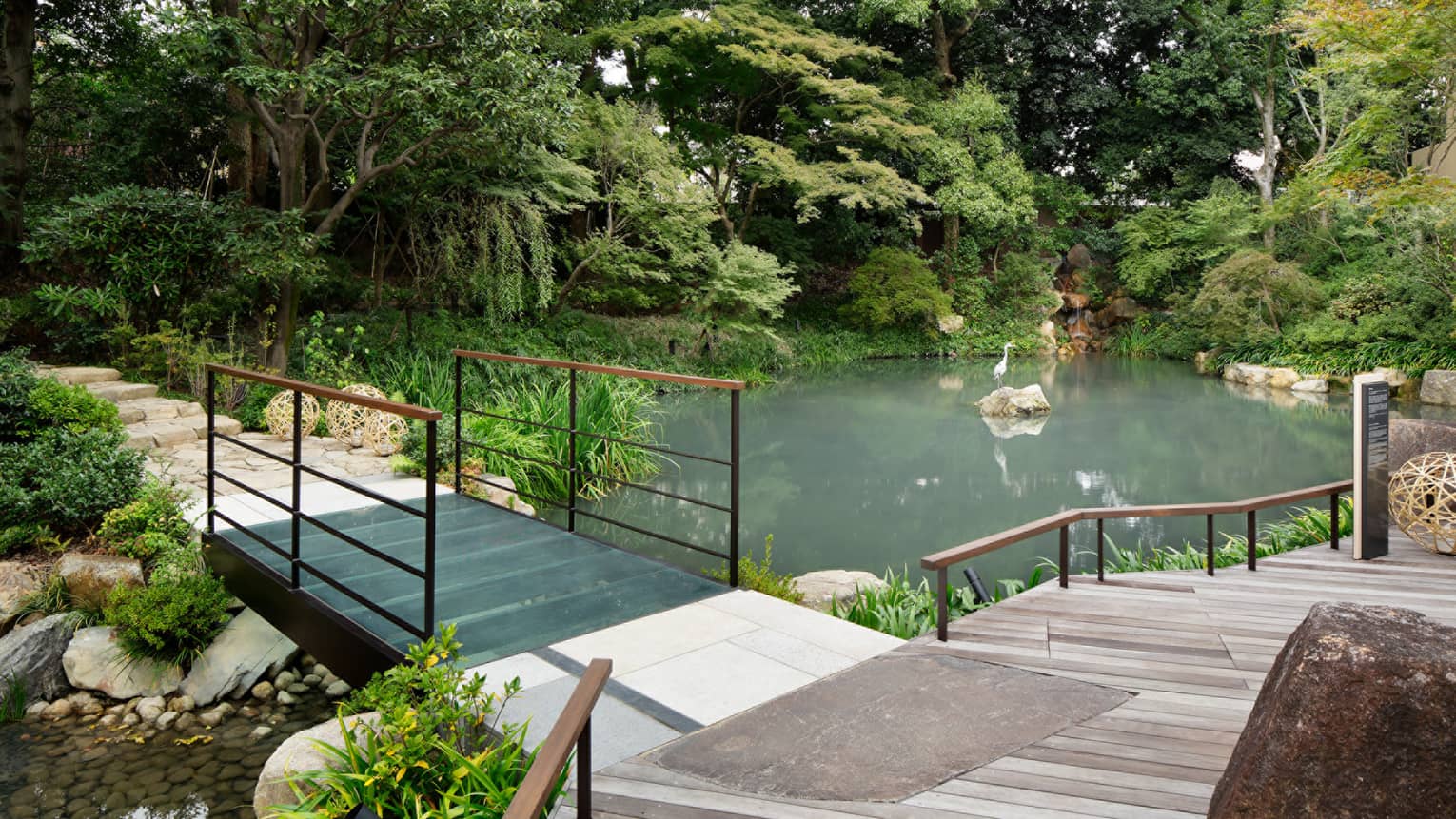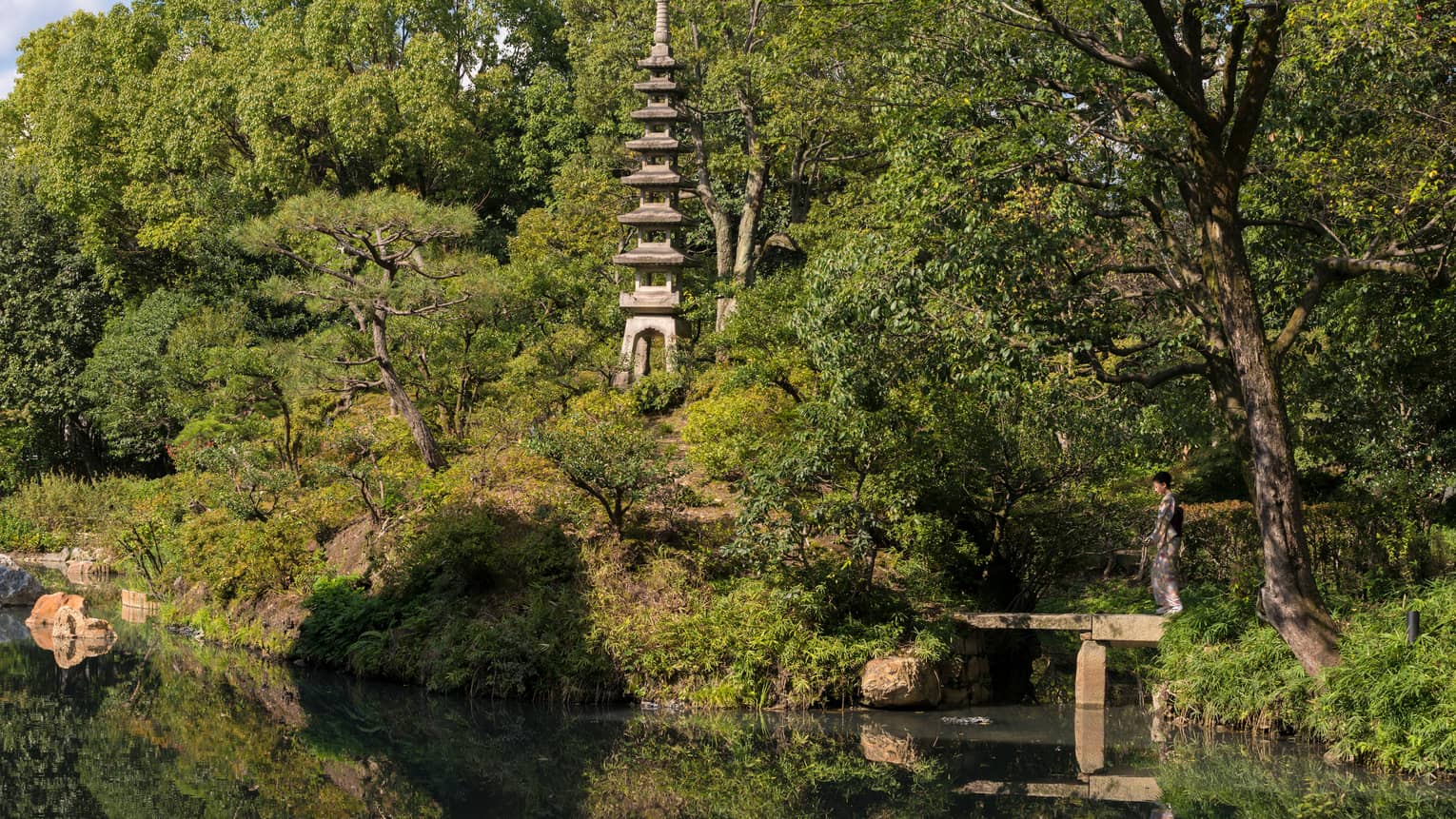Style and Architecture

The Shakusui-en pond garden is long and narrow, extending from west to east, where the Higashiyama Mountains come in to view. The pond garden is divided into two parts: Oike (large pond) and Koike (small pond). A stone bridge separates the two, with remnants of an old stone waterfall visible on the small pond side. The large pond features an Oshima (large island) to the east and a Koshima (small island) in the centre.
History
Highlights
 Stone and Glass Bridges
Stone and Glass Bridges Waterfall
Waterfall Jizo and Pagoda
Jizo and Pagoda Wildlife
Wildlife
- Large and Small Islands
- Near Oshima (large island), you will see five Yodomari-ishi arranged in a row. On the surface, these look like a single stone, but in fact, two are joined underwater in the shape of a human form, a method of stone assembly that dates back to the early Heian period. In addition, you can see several islands made of stones called “gantou” near the Koshima (small island). Created by erosion from the island, these stones are believed to have been part of a stone retaining wall that researcher Mirei Shigemori linked to traces of the old garden.
- Yodomari-ishi/Yahakuseki
- Symbolic in nature, Yodomari-ishi (also pronounced as Yahakuseki) is a group of five stones lined up near Oshima (large island) to represent sailboats anchored at night that are bound for Horai Island to seek treasure. Horai Island is an imaginary island where immortals dwell in Chinese mythology. You can also see Yodomari-ishi in Kyoto’s gardens of Saiho-ji Temple, Kinkaku-ji Temple (Golden Pavilion) and Daikaku-ji Temple.
- Stone and Glass Bridges
- The stone bridge that now divides the large and small ponds is part of the garden’s ancient heritage. To preserve its archaeological significance for future generations, a special bridge of tempered glass has been built around it, enabling visitors to see the stonework below.
- Waterfall
- The waterfall was restored by using original stones and existing stonework based on the garden researcher Mirei Shigemori’s measured map and his study from the 1930s. Renewing the water circulation system, such as adjusting the amount of groundwater flowing into the pond and relocating the water source point, aided to improve the water quality and bring back the waterscape in great condition as it was before.
- Jizo and Pagoda
- Jizo is a statue believed to be full of compassion and fortitude used for protection as a guardian. According to our neighbourhood temple, Myoho-in Temple, Jizo has been in our garden since the middle of the Edo era (1603–1868). The pagoda has been on the Oshima (large island) for almost a century.
- Garden Wildlife
- Carp, turtles, dragonflies, ducks, crayfish, and herons can be seen in our Shakusui-en pond garden.
Tea House – Traditions and Cultures through our Sukiya-style Tea House

Sukiya-style is based on the Japanese aesthetic of wabi-sabi and often used in traditional tea houses. Designed by local architect Ryosuke Yamamoto, a true Japanese Shokunin (craftsmen), it‘s built mostly with cypress wood from Kyoto, and its interior space is even more beautiful when lit through a Japanese umbrella on the ceiling. The floor features soil from the Fushimi area in Kyoto, creating the warm atmosphere in the Tea House. The Tea House comprises two spaces, Fuju and Shakusui-tei. Enjoy views of Japanese paintings like our 800-year-old historic garden through glass doors.
 Fuju
FujuNamed by the priest of Myoho-in Temple after the poetic word for a maple tree, FUJU draws on its unique location, Higashiyama, in a space historically revered for momijigari – the Japanese tradition of gazing at autumn colours – to offer a year-round connection to Kyoto’s artistry, traditions and natural beauty. Equally captivating by day as by night, it’s the perfect spot for a private morning zen yoga or a meditation session over the pond or for hosting an evening with Maiko and Geiko to delight in the decadence and artistry of traditional Japanese entertaining.
Details Shakusui-tei
Shakusui-teiAdjacent to Fuju lies a special secret: Shakusui-tei, an intimate tea ceremony room designed to immerse up to five guests in the spiritual beauty and traditional craft of Japanese practices. Book a private ceremony with a renowned local tea artist.
Details
